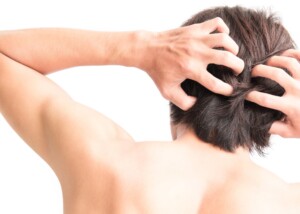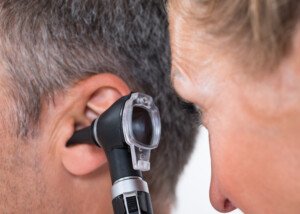
Discovering crud or crusty gunk behind your ear can be an unnerving experience, making you wonder if it’s skin cancer.
But here’s something to keep in mind: Skin cancer rarely presents as a clump of gooey, moist crud.
Sure, an untreated basal cell carcinoma could grow into something hideous and oozing, but that’s only after years of neglect and letting it grow to an advanced stage.
Melanoma, the deadliest of skin cancers, can ooze and crust, but it won’t have the same behavior as the much more common crud and crust that develops behind the lower ear.
The tip-off that the crud behind your lower ear is not cancer is that it can be easily rubbed away with a finger.
A skin cancer cannot be easily rubbed away—not any more than a common mole can be simply rubbed away.
Another reassuring tipoff is that the crud rapidly returns after you rub it off the ear.
In fact, a reassuring sign is when it easily wipes off onto your finger and you can see the crud on your finger. This sounds gross but it’s a sign that strongly points to a benign condition.
So then, what most likely IS that crud behind the lower ear?
“Yes, it can be seborrheic dermatitis, but it can also just be due to normal skin shedding mixed with dirt (wash behind your ears and this is less likely to be a problem),” says Susan L. Besser, MD, with Mercy Medical Center, Baltimore, and Diplomate American Board of Obesity Medicine and board certified by the American Board of Family Medicine.
Though many people neglect to routinely wash behind their ears, seborrheic dermatitis is a common cause of the crusty buildup – perhaps THE most common cause.
This is a very common and benign skin condition, involving the sebaceous glands, that typically affects the skin on the nose, between the eyebrows, the eyelids and area above the eyelids (below the brows). It can also affect the back.
The classic presentation is a pinkish-orange, or salmon colored, patchy area that flakes or peels, and also itches.
Sometimes a clump of what appears to be yellowish dead skin forms. When especially irritated, the area will ooze a yellowish gunk.
Crusty oozing crud can form around the creases of the nose. And it may sting.
This same crust, crud and gunk can also form behind the lower ears.
An ointment can be prescribed, though daily applications of dandruff shampoo may also work.
Dab the shampoo on with a fingertip, then gently blot off with a wet rag or makeup pad. NEVER RUB.
Picking it off or rubbing it off with a finger will make it worse.
 Dr. Besser provides comprehensive family care, treating common and acute primary conditions like diabetes and hypertension. Her ongoing approach allows her the opportunity to provide accurate and critical diagnoses of more complex conditions and disorders.
Dr. Besser provides comprehensive family care, treating common and acute primary conditions like diabetes and hypertension. Her ongoing approach allows her the opportunity to provide accurate and critical diagnoses of more complex conditions and disorders.
 Lorra Garrick has been covering medical, fitness and cybersecurity topics for many years, having written thousands of articles for print magazines and websites, including as a ghostwriter. She’s also a former ACE-certified personal trainer.
Lorra Garrick has been covering medical, fitness and cybersecurity topics for many years, having written thousands of articles for print magazines and websites, including as a ghostwriter. She’s also a former ACE-certified personal trainer.
.









































